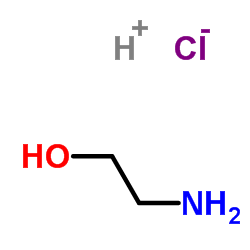β-Aminoethanol hydrochloride

β-Aminoethanol hydrochloride structure
|
Common Name | β-Aminoethanol hydrochloride | ||
|---|---|---|---|---|
| CAS Number | 2002-24-6 | Molecular Weight | 97.544 | |
| Density | N/A | Boiling Point | 170.9ºC at 760 mmHg | |
| Molecular Formula | C2H8ClNO | Melting Point | 82-84 °C(lit.) | |
| MSDS | USA | Flash Point | 93.3ºC | |
| Symbol |

GHS07 |
Signal Word | Warning | |
|
Sensitive and selective analysis of a wide concentration range of IGFBP7 using a surface plasmon resonance biosensor.
Colloids Surf. B Biointerfaces 123 , 887-91, (2014) A sensitive method for selectively detecting insulin-like growth factor-binding protein 7 (IGFBP7) over a wide range of concentrations based on the surface plasmon resonance (SPR) biosensing techniques is described. IGFBP7 has been shown to regulate cell prol... |
|
|
Surface plasmon resonance-based immunoassay for human C-reactive protein.
Analyst 140 , 4445-52, (2015) A rapid and highly-sensitive surface plasmon resonance (SPR)-based immunoassay (IA) has been developed and validated for detecting human C-reactive protein (CRP), a specific biomarker for inflammatory and metabolic disorders, and infections. The 1-ethyl-3-(3-... |
|
|
A polydopamine-modified optical fiber SPR biosensor using electroless-plated gold films for immunoassays.
Biosens. Bioelectron. 74 , 454-60, (2015) A sensitive and stable electroless-plated gold film for the preparation of an optical fiber surface plasmon resonance (SPR) sensor is presented in this work, together with a facile antibody immobilization method. Gold nanoparticles were uniformly adsorbed ont... |
|
|
Enzymatic properties and substrate specificity of a bacterial phosphatidylcholine synthase.
FEBS J. 281(15) , 3523-41, (2014) Phosphatidylcholine (PC) is a rare membrane lipid in bacteria, but is crucial for virulence of the plant pathogen Agrobacterium tumefaciens and various other pathogens. Agrobacterium tumefaciens uses two independent PC biosynthesis pathways. One is dependent ... |
|
|
Invincible DNA tethers: covalent DNA anchoring for enhanced temporal and force stability in magnetic tweezers experiments.
Nucleic Acids Res. 42(18) , e137, (2014) Magnetic tweezers are a powerful single-molecule technique that allows real-time quantitative investigation of biomolecular processes under applied force. High pulling forces exceeding tens of picoNewtons may be required, e.g. to probe the force range of prot... |
|
|
Enhanced angiogenesis of growth factor-free porous biodegradable adhesive made with hexanoyl group-modified gelatin.
Biomaterials 63 , 14-23, (2015) The bonding behavior of hexanoyl (Hx: C6) group-modified alkaline-treated gelatin (HxAlGltn) porous films ((P)HxAlGltn) on the porcine intestine was evaluated. (P)HxAlGltns with various porosities were prepared by the salt-leaching method for various solid-li... |
|
|
Surface plasmon resonance assay of inhibition by pharmaceuticals for thyroxine hormone binging to transport proteins.
Anal. Biochem. 492 , 43-8, (2015) We developed a surface plasmon resonance (SPR) assay to estimate the competitive inhibition by pharmaceuticals for thyroxine (T4) binding to thyroid hormone transport proteins, transthyretin (TTR) and thyroxine binding globulin (TBG). In this SPR assay, the c... |
|
|
Amperometric magnetoimmunoassay for the direct detection of tumor necrosis factor alpha biomarker in human serum.
Anal. Chim. Acta 838 , 37-44, (2014) An amperometric immunoassay for the determination of tumor necrosis factor alpha (TNFα) protein biomarker in human serum based on the use of magnetic microbeads (MBs) and disposable screen-printed carbon electrodes (SPCEs) has been developed. The specifically... |
|
|
Amperometric magnetoimmunosensor for ErbB2 breast cancer biomarker determination in human serum, cell lysates and intact breast cancer cells.
Biosens. Bioelectron. 70 , 34-41, (2015) A highly sensitive amperometric magnetoimmunosensor for the determination of ErbB2 protein, a well-known biomarker related to high-impact high-incidence diseases such as breast cancer, is described. A sandwich format involving the covalent immobilization of a... |
|
|
Phosphatidylethanolamine positively regulates autophagy and longevity.
Cell Death Differ. 22(3) , 499-508, (2015) Autophagy is a cellular recycling program that retards ageing by efficiently eliminating damaged and potentially harmful organelles and intracellular protein aggregates. Here, we show that the abundance of phosphatidylethanolamine (PE) positively regulates au... |